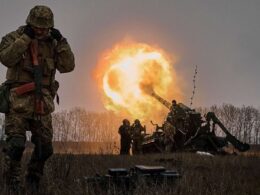EYEWITNESS INTERVIEW
Ann Katrin Orr spoke to René Henze for the Socialist about the movement that led to the collapse of the Berlin Wall and the effects of reunification and reintroduction of capitalism in East Germany. René was born and lives in Eastern Germany, he was 26 and part of the left opposition in the GDR when the Berlin Wall collapsed and has been a socialist and an activist since the early 1980s. He is a member of the SAV (CWI in Germany).
How were the recent celebrations of the collapse of the Berlin Wall perceived by people in Eastern Germany?
Most people simply didn’t take part in the celebrations. They had nothing to do with ordinary people but were orchestrated by the ruling class for their own interests. Most of those who were part of the opposition during 1989 (if they haven’t since become part of the establishment) are shocked to find what the pursuit of their ideals 20 years ago has led to.
So reunification with West Germany wasn’t a goal of the mass movements in the GDR at the time?
The opposition groups that were formed in the period before the collapse of the Berlin Wall saw themselves as pro-socialist and did not want accession of the GDR to West Germany. They were also all against Stalinism.
To be precise, the revolution in 1989 had three phases: At first people wanted to have the right to leave the GDR. Then on the first Monday demonstration in Leipzig on 4 September over 1,000 demonstrators chanted “We’re staying here!” They also used the slogan “We are the people” to undermine the legitimacy of the government of the GDR. It wasn’t until late in November that the first German flags were seen on protests in Leipzig. The calls for reunification grew louder and more frequent as time moved on, particularly after the collapse of the Wall when many Eastern Germans got the chance to see the range of consumer goods available in the West. On top of that there was hope for financial help from flourishing West German big-businesses and the desire for democracy which people saw in the Western system.
Do you think it was inevitable that the movement would turnaround and lead to the restoration of capitalism in the GDR?
No. What lead to this was the lack of a clear programme from the left opposition forces within the GDR of how to revive the economy in East Germany and how to oust the Stalinist Socialist Unity Party of Germany (SED) leadership from power. If this had existed the mass movements of 1989 could have taken a different path. But sadly, the leaders of the opposition, while being honest people, were not Marxists and they lacked Trotsky’s analysis of the Stalinist system. On top of that, most of the leaders were intellectuals – they were academics and did not have a connection to the mass of ordinary people – that was their second weakness.
Every Monday hundreds of thousands of people went out on the streets in nearly every city in the GDR. Committees were formed as well as independent trade unions associations. Students, workers, residents, apprentices – even prisoners formed their own councils. The opposition groups failed to link these initiatives together on a national scale – that would have posed the opportunity of taking power from the Stalinist SED and of giving it to the masses.
You mentioned that people were hoping for financial help from the West after re-unification, did this happen?
Well, the West German government did make huge amounts of public money available for the development of the Eastern part of the country. But of course the contracts went to West German companies. The state had to foot the bill for the quickly developing mass unemployment though.
At the same time, cash flowed straight into the pockets of West German supermarket chains. It was a gigantic redeployment of public money into the private pockets of big-business.
Can you tell us some more about the effects of the reintroduction of the market economy in the former GDR on the lives of ordinary people there?
Three quarters of industrial jobs in Eastern Germany have been destroyed since the reunification. The result of this is “brain drain” with young, educated people leaving the region. Whole cities and regions are becoming desolate. That’s the reality of capitalism in Eastern Germany. Unemployment is between 13 and 14% and is set to rise even higher in the context of the economic crisis.
In the 1980s the IMF ranked the GDR as the 10th most developed country in the world – the standard of living was even higher than in the UK. Today, Eastern Germany’s economic power is only equal to that of Schleswig-Holstein, Germany’s most agricultural federal state.
“Ostalgie” (nostalgia for life in the GDR) is well known. Do people in Eastern Germany really want to go back to the way things were like in the GDR?
Of course people want the social security, good and free healthcare and education systems. Because of the planned economy there was no competition between people, the coldness and individualisation of people today also bothers many here. There was no unemployment in the GDR. All of these are things people in Eastern Germany are hoping for again. But the return of a Stalinist regime of the GDR-state as such is not what people in Eastern Germany want.












